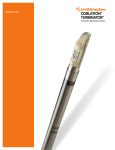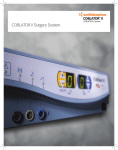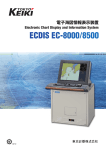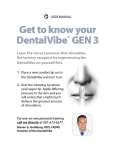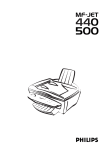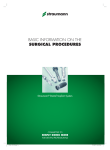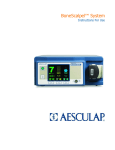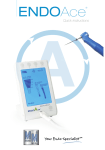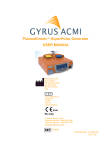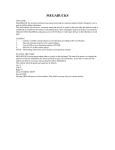Download TURBINATOR turbinate reduction Wand
Transcript
Technique Guide Reduce hypertrophic turbinates submucosally and provide hemostasis with built-in bipolar coag The TURBINATOR™ turbinate reduction Wand is designed to provide immediate, visible removal of submucosal tissue of hypertrophic turbinates. The TURBINATOR Wand’s bipolar coagulation feature delivers targeted hemostasis. Surgical technique Preoperative preparation Refer to the User’s Manual for set up of the Controller, irrigation pump, and foot pedal. NOTE: Do not use the Flow Control Valve (FCV) with the TURBINATOR turbinate reduction Wand. Proximal depth marker Orientation line Middle depth marker Distal depth marker Active electrode 2.9mm 15mm 15mm 12mm Local anesthesia may be administered with or without a vasoconstrictor per the surgeon’s preference. Depth markers are provided on the device shaft to use as a guide to determine the depth of insertion into the turbinate. Refer to the image above for the position of depth markers. The device also has a longitudinal line along the shaft to provide an indication of the active electrode orientation when inserted in the turbinate. Setup 1 Connect the saline line to the irrigation pump, suction tubing to an active suction device, and the connector cable to the COBLATOR™ II Controller per the Instructions for Use (IFU) included with the TURBINATOR Wand. The irrigation pump should be set to medium flow. The Wand will default to the recommended Ablate (7) and Coag (3) settings. The rate and depth of tissue ablation is affected by the set point selected, the amount of pressure on the tissue, the integrity of the electrode, and the speed at which the Wand is passed over the target tissue. Recommended suction pressure is 250350mm Hg. CAUTION: When priming Wand irrigation line and setting the flow rate, hold Wand tip away from patient as dripping irrigant could result in patient burns. Please refer to the Instructions for Use (IFU) packaged with the product for a complete list of warnings, precautions and contraindications. Saline delivery ports on back of tip Surgical procedure 1 Use a scalpel to make an initial incision in the anterior portion of the inferior turbinate; a freer elevator or equivalent should be used to create a mucosal pocket. Insert the TURBINATOR™ Wand transnasally until the tip of the Wand is inside the initial incision. Advance the Turbinator Wand into the anterior mucosa, tracking along the medial surface of the turbinate bone. Insert Wand through incision During insertion, the dissecting edge of the Wand tip should be kept adjacent to the turbinate bone. The Wand should not be activated during insertion. 2Continue to advance the TURBINATOR Wand along the turbinate bone to the desired depth of the turbinate to be treated. Once the Wand is positioned at the desired depth, orient the active electrode towards the tissue targeted for resection. Orient electrode towards targeted tissue 3Activate the TURBINATOR Wand by depressing the yellow Ablate foot pedal. Begin slowly retracting the Wand through the targeted tissue (up to 5 seconds). Activate Wand using Ablate pedal 4Stop activation when the distal depth marker is visible at the surface of the mucosa. Stop removal when first marker is visible Additional procedural recommendations: AThe Wand tip should be inserted up to the distal depth marker or deeper during activation. Do not activate if most distal marker is visible outside tissue. BIt is not recommended to activate the Wand continuously for more than 5 seconds during a single activation. CThe proximal and middle depth markers are for reference only. Take care not to advance the Wand through the mucosa in order to reach one of these markers. DIf mucosal blanching is observed, stop activation and reposition Wand as needed to remove targeted tissue. EIf procedure is completed under direct visualization, the orange glow from the Wand may be visible through the mucosa to help provide additional guidance for tip orientation and position. If the procedure is performed using an endoscope, the orange glow may not be visible. 5If hemostasis is required, orient the active electrode towards target tissue and press the Coag foot pedal while retracting slowly with rotation of 180 degrees for up to 10 seconds. NOTE: If mucosal blanching is observed, stop activation. Reposition and repeat as needed to achieve hemostasis. NOTE: Clogging of the Wand suction is typically caused by large, ablated tissue remnants. Wiping off the Wand tip with a wet gauze or surgical towel between passes can help to prevent clogging of the Wand. Should the Wand suction become clogged, intermittently dip the tip of the Wand into a saline filled nonmetallic beaker and press the yellow Ablate foot pedal to flush out the Wand’s suction port. If the Wand remains clogged, fill a 10-20cc syringe with saline and back flush the suction port of the Wand while pressing the Ablate pedal. CAUTION: Avoid allowing saline to fall in areas not being treated as user or patient thermal injury may result. When priming or cleaning the Wand, hold the Wand over a towel away from the patient to collect the saline. Ordering information TURBINATOR™ turbinate reduction Wand Reference # Description EICA6895-01TURBINATOR WAND EC8000-01COBLATOR™ II SYSTEM CONTROLLER SIP001-00SALINE IRRIGATION PUMP ArthroCare Corporation 7000 West William Cannon Drive Austin, TX 78735 USA www.smith-nephew.com Order Entry: 1-800-343-5717 Order Entry Fax: 1-888-994-2782 © 2015 Smith & Nephew, Inc. ™Trademark of Smith & Nephew. Reg. US Pat. & TM Office. P/N 52371 Rev. C 01/15




